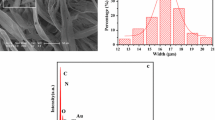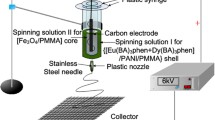Abstract
In order to develop new-typed multifunctional composite nanobelts, polymethyl methacrylate (PMMA) is used as the matrix to construct composite nanobelts containing different amounts of Eu(BA)3phen(BA = benzoic acid, phen = phenanthroline), polyaniline (PANI) and Fe3O4 nanoparticles (NPs), and Eu(BA)3phen/PANI/Fe3O4/PMMA trifunctional composite nanobelts with simultaneous photoluminescence, electricity and magnetism have been successfully fabricated via electrospinning technology. The morphology and properties of the obtained composite nanobelts were characterized by X-ray diffractometry, scanning electron microscopy, vibrating sample magnetometry, fluorescence spectroscopy and Hall effect measurement system. The results indicate that the trifunctional composite nanobelts simultaneously possess excellent photoluminescence, electrical conduction and magnetic properties. Fluorescence emission peaks of Eu3+ ions in the composite nanobelts are observed and assigned to the energy levels transitions of 5D0 → 7F0 (580 nm), 5D0 → 7F1 (593 nm) and 5D0 → 7F2 (615 nm) of Eu3+ ions, and the 5D0 → 7F2 hypersensitive transition at 615 nm is the predominant emission peak. The electrical conductivity reaches up to the order of 10−3 S/cm. Furthermore, the luminescent intensity, electrical conductivity and saturation magnetization of the composite nanobelts can be tunable by adjusting amounts of Eu(BA)3phen, PANI and Fe3O4 NPs. The formation mechanism of the composite nanobelts is also proposed. The obtained photoluminescence–electricity–magnetism trifunctional composite nanobelts have potential applications in many areas such as electromagnetic interference shielding, microwave absorption, molecular electronics, biomedicine and future nanomechanics. More importantly, the design concept and construct technique are of universal significance to fabricate other trifunctional naonobelts.









Similar content being viewed by others
References
W. Sambaer, M. Zatloukal, D. Kimmer, Chem. Eng. Sci. 66, 613–623 (2011)
J.M. Corres, Y.R. Garcia, F.J. Arregui, I.R. Matias, IEEE Sens. J. 11, 2383–2387 (2011)
S.A. Sell, P.S. Wolfe, J.J. Ericksen, D.G. Simpson, G.L. Bowlin, Tissue Eng. Part A 17, 2723–2737 (2011)
S.L. Chen, H.Q. Hou, F. Harnisch, S.A. Patil, A.A. Carmona-Martinez, S. Agarwal, Y.Y. Zhang, S. Sinha-Ray, A.L. Yarin, A. Greiner, U. Schröder, Energy Environ. Sci. 4, 1417–1421 (2011)
M. Alvaro, V. Fornés, S. García, H. García, J.C. Scaiano, J. Phys. Chem. B 102, 8744–8750 (1998)
Q. Xu, L. Li, X. Liu, R. Xu, Chem. Mater. 14, 549–555 (2002)
H. Li, S. Inoue, K. Machida, G. Adachi, Chem. Mater. 11, 3171–3176 (1999)
H.Y. Feng, S.H. Jian, Y.P. Wang, Z.Q. Lei, R.M. Wang, J. Appl. Polym. Sci. 68, 1605–1611 (1998)
Q. Ling, M. Yang, Z. Wu, X. Zhang, L. Wang, W. Zhang, Polymer 42, 4605–4610 (2001)
D.H. Zhang, Y.Y. Wang, Mater. Sci. Eng., B 134, 9–19 (2006)
S. Virji, R.B. Kaner, B.H. Weiller, Chem. Mater. 17, 1256–1260 (2005)
Q.H. Zhang, H.F. Jin, X.H. Wang, X.B. Jing, Synth. Met. 123, 481–485 (2001)
J. Huang, S. Virji, B.H. Weiller, R.K. Prof, Chem. Eur. J. 10, 1314–1319 (2004)
Q.Z. Yu, M.M. Shi, M. Deng, M. Wang, H.Z. Chen, Mater. Sci. Eng., B 150, 70–76 (2008)
F. Chabert, D.E. Dunstan, G.V. Franks, J. Am. Ceram. Soc. 91, 3138–3146 (2008)
J.B. Ballengee, P.N. Pintauro, J. Electrochem. Soc. 158, B568–B572 (2011)
D.S. Tang, S.S. Xie, Z.W. Pan, L.F. Sun, Z.Q. Liu, X.P. Zou, Y.B. Li, L.J. Ci, W. Liu, B.S. Zou, W.Y. Zhou, Chem. Phys. Lett. 356, 563–566 (2002)
M.C.K. Wiltshire, J.B. Pendry, I.R. Young, D.J. Larkman, D.J. Gilderdale, J.V. Hajnal, Science 291, 849–851 (2001)
P. Trivedi, L. Axe, Environ. Sci. Technol. 34, 2215–2223 (2000)
S. Bucak, D.A. Jones, P.E. Laibinis, Biotechnol. Progr. 19, 477–484 (2003)
S.V. Kolotilov, O. Cador, F. Pointillart, S. Golhen, Y.L. Gai, K.S. Gavrilenko, L. Ouahab, J. Mater. Chem. 20, 9505–9514 (2010)
B.K. Balan, V.S. Kale, P.P. Aher, M.V. Shelke, V.K. Pillai, S. Kurunqut, Chem. Commun. 46, 5590–5592 (2010)
P. Lu, J.L. Zhang, Y.L. Liu, D.H. Sun, G.X. Liu, G.Y. Hong, J.Z. Ni, Talanta 82, 450–457 (2010)
H. Peng, G. Liu, X. Dong, J. Wang, W. Yu, J. Alloys Compd. 509, 6930–6934 (2011)
W. Wang, M. Zou, K. Chen, Chem. Commun. 46, 5100–5102 (2010)
Q.L. Ma, W.S. Yu, X.T. Dong, J.X. Wang, G.X. Liu, J. Xu, J. Nanopart. Res. 14, 1–7 (2012)
Q.L. Ma, W.S. Yu, X.T. Dong, J.X. Wang, G.X. Liu, J. Xu, Opt. Mater. 35, 526–530 (2013)
Y.H. Wang, J.X. Wang, X.T. Dong, W.S. Yu, G.X. Liu, Chem. J. Chin. U 8, 1657–1662 (2012)
R. Katal, S. Pourkarimi, E. Bahmani, H.A. Dehkordi, M.A. Ghayyem, H. Esfandian, J. Vin, Addit. Technol. 19, 147–156 (2013)
S.B. Meshkova, J. Fluoresc. 10, 333–337 (2000)
Y.F. Zhu, W.R. Zhao, H.R. Chen, J.L. Shi, J. Phys. Chem. C 111, 5281–5285 (2007)
Q. Gao, F.H. Chen, J.L. Zhang, G.Y. Hong, J.Z. Ni, X. Wei, D.J. Wang, J. Magn. Magn. Mater. 321, 1052–1057 (2009)
S. Xuan, L. Hao, W. Jiang, X. Gong, Y. Hu, Z. Chen, J. Magn. Magn. Mater. 308, 210–213 (2007)
Acknowledgments
This work was financially supported by the National Natural Science Foundation of China (NSFC 50972020, 51072026), Specialized Research Fund for the Doctoral Program of Higher Education (20102216110002,20112216120003), the Science and Technology Development Planning Project of Jilin Province (Grant Nos. 20130101001JC, 20070402, 20060504), the Research Project of Science and Technology of Department of Education of Jilin Province “11th 5-year plan” (Grant Nos. 2010JYT01), Key Research Project of Science and Technology of Ministry of Education of China (Grant No. 207026).
Author information
Authors and Affiliations
Corresponding authors
Rights and permissions
About this article
Cite this article
Sheng, S., Ma, Q., Dong, X. et al. A single nanobelt to achieve simultaneous photoluminescence–electricity–magnetism trifunction. J Mater Sci: Mater Electron 25, 2279–2286 (2014). https://doi.org/10.1007/s10854-014-1872-8
Received:
Accepted:
Published:
Issue Date:
DOI: https://doi.org/10.1007/s10854-014-1872-8




